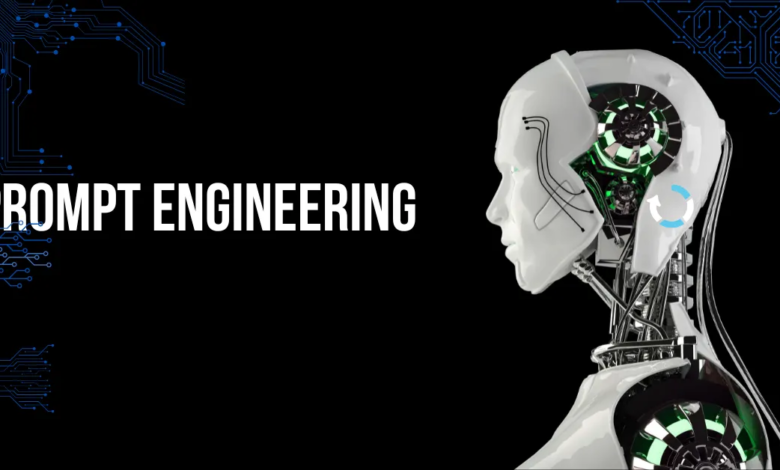Prompting: Getting AI Models to Generate What You Want

In the field of artificial intelligence, AI Models to Generate to perform precisely as we want them to may be a difficult and time-consuming endeavor. Despite the enormous potential they have, developing the ideal trigger to direct one of these models may be a challenging endeavor.
Learning how to craft compelling prompts is the skill that has to be mastered in order to release the full potential of AI models. We can influence artificial intelligence models to generate the intended outputs more consistently if we refine our interactions and stay clear of frequent errors.
What is a prompt?
Interacting with AI models requires the use of AI prompts, which serve as the impetus for the AI model’s cognitive process and are thus crucial. They might be as clear and easy to understand as simple inquiries, or they can be more complicated and subtle, requiring the AI to synthesize information, make conclusions, or propose innovative answers. Because the quality and clarity of a prompt may have a significant impact on the output created by an AI model, it is essential to construct prompts that effectively represent the user’s intended purpose and the result they want to achieve.
Zero-shot prompting
When using zero-shot prompting, the AI model depends exclusively on the information it has already acquired, including its general comprehension of language and its ability to reason and infer from the information that is contained inside the vast language of the prompt. This strategy is in contrast to few-shot learning and many-shot learning, both of which involve providing the model with a restricted or extensive number of instances, respectively, to assist in guiding its answers.
Example
Imagine that you have access to a potent AI language model such as GPT-3 that has been trained on a massive dataset of text taken from a variety of different sources. You would want the AI language models to offer a summary of the article that you submit.
You might employ zero-shot prompting by only presenting the AI model with the content of the article, and then following it up with a condensed command such as “Please summarize the following article in three sentences:” The artificial intelligence model would then evaluate the material that was provided as input, identify the most salient aspects, and write a summary even though it had not been specifically trained on the job of summarizing articles.
This is conceivable due to the fact that GPT-3, along with other AI models of a similar kind, have a comprehensive language model and access to a broad variety of text throughout their training. This provides them with the ability to generalize and carry out new tasks, such as summarization, even in the absence of specific examples or previous training on that particular activity.

One-shot prompting
A method called one-shot prompting is employed with artificial intelligence models. In this approach, the model is provided with a task description and a single example to learn from in order to provide a response to a given prompt. The AI model consults this task description and example as a point of reference in order to acquire an understanding of the task and provide output that is acceptable.
One-shot prompting achieves a compromise between zero-shot prompting, which gives soft prompts but no examples, and few-shot or many-shot learning, which incorporates several instances to influence the model’s replies. In other words, zero-shot prompting provides soft prompts but no examples, whereas one-shot prompting provides examples.
A Primer On
Let’s say you wish to convert temperatures from Fahrenheit to Celsius using ChatGPT, and we’ll assume that you are utilizing it. You just offer the AI one example to study in order to teach it, rather than presenting it with several instances or none at all.
A method called one-shot prompting is employed with artificial intelligence models. In this approach, the model is provided with a task description and a single example to learn from in order to provide a response to a given prompt. The AI model consults this task description and example as a point of reference in order to acquire an understanding of the task and provide output that is acceptable.
One-shot prompting achieves a compromise between zero-shot prompting, which gives soft prompts but no examples, and few-shot or many-shot learning, which incorporates several instances to influence the model’s replies. In other words, zero-shot prompting provides soft prompts but no examples, whereas one-shot prompting provides examples.
A Primer On
Let’s say you wish to convert temperatures from Fahrenheit to Celsius using ChatGPT, and we’ll assume that you are utilizing it. You just offer the AI one example to study in order to teach it, rather than presenting it with several instances or none at all.

Few-shot prompting
Few-shot prompting is a method that is used with artificial intelligence models in which the model is only given a limited number of instances (typically between 2 and 10) to learn from and develop a response to a given prompt. Typically, the range for the number of examples is between 2 and 10. These instances serve as a reference, which enables the model to acquire a deeper comprehension of the activity and provide outputs that are more precise.
One-shot prompting provides less assistance to the artificial intelligence model than few-shot prompting does, but few-shot prompting still eliminates the need for significant amounts of training data. It allows the model to generalize from the few instances that have been supplied and apply that knowledge to new prompts that have not been seen before.
What is prompt engineering?
When dealing with AI Models to Generate, prompt engineering is an essential component since AI models are, at their core, hand-designed prompts created by humans. This is especially true for models that rely on natural language processing. It entails building and tweaking prompts to increase the performance, reliability, and utility of an AI model. This is done to ensure that the produced outputs are in line with the user’s goal and intended result.
The procedure entails coming up with prompts that are both clear and succinct, while also offering context and examples as required. It frequently requires repeated tweaking in order to determine the best effective prompt structure and language for a particular job. Users will be able to acquire results from AI models that are more accurate, relevant, and dependable if they learn prompt engineering, which will in turn lead to interactions that are more efficient and productive.
How does prompt engineering work?
The primary objective of prompt engineering is to optimize the model’s performance, accuracy, and utility by painstakingly building prompts that express the user’s purpose and the expected consequence. This is accomplished by carefully designing prompts that communicate the user’s intent and the desired outcome. This is accomplished by the use of a variety of strategies and factors, some of which include the provision of detailed instructions, an adequate context, and examples when appropriate.
A Primer On
Imagine that you are using ChatGPT to get a synopsis of a book that you have read. Rather of presenting a prompt that is up to interpretation, such as “Tell me about this book,” you may employ approaches from the field of prompt engineering to construct a more effective prompt.
A better question to ask might be something along the lines of, “Please provide a brief summary of the novel ‘To Kill a Mockingbird’ by Harper Lee, including a description of the novel’s primary themes and characters, in approximately one hundred words.”
In this particular instance, the admonition is unambiguous, detailed, and gives context. The AI model now has a deeper comprehension of the undertaking, allowing it to provide a summary that is both more accurate and relevant.
Prompt engineering is an iterative process, which requires trial and refining to discover the best approach to express the intended job to the AI model. This is necessary in order to identify the most effective way to do the task. Users are able to acquire results from AI models that are more accurate, relevant, and dependable if they have mastered prompt engineering. This, in turn, leads to interactions with bigger models that are more efficient and productive.
Why is prompt engineering important?
To fully tap into the potential of AI models, especially those that are centered on natural language processing, prompt engineering is an essential component that must not be overlooked. The direct influence that timely engineering has on the quality, accuracy, and relevance of the model’s output is the primary reason for the significance of this practice. Not only can a well constructed prompt improve the user experience, but it may also reduce the difficulty of a job by supplying the model with the proper direction and clarity. When this is done, ambiguity is cleared up, overall efficiency is improved, and time and resources are saved as a result of a reduction in the number of needed repetitions to achieve the desired result.
In addition, rapid engineering makes it possible to customize the replies provided by the AI model. This gives users the ability to cater the responses to their own requirements or preferences. As a consequence, the outputs are improved in terms of their contextual relevance and degree of personalization. In addition to being an essential part of timely engineering, the function it plays in resolving ethical concerns is also very important. It is possible to stop AI models from producing potentially damaging, prejudiced, or offensive information by programming the prompts that they utilize with the necessary limitations and rules. This aligns the outputs with ethical concerns and the expectations of users. In summary, prompt engineering is vital for improving interactions between users and AI models. This is because it ensures that the produced outputs satisfy user expectations and adapt to the unique demands of the users, which eventually leads to interactions that are more efficient and productive.

Which method is easiest?
As we investigate a variety of approaches to AI Models to Generate optimization, there is a discernible increase in the amount of machine learning skill that is needed on our part. It is not necessary to have an in-depth understanding of the machine learning models in order to engage in prompt engineering, which focuses on the creation of efficient input prompts. As a result, people with minimal technical backgrounds may use this technique.
A deeper understanding of machine learning is going to become absolutely necessary as we get to more sophisticated approaches such as prompt tuning and fine-tuning. Fine-tuning requires further training of the original model on a particular dataset customized to the user’s requirements, while prompt tuning entails working with the AI model and providing it with the required prompts. Prompt tuning may be accomplished by interacting with the AI model. Even though it is not discussed in this article, the approach known as reinforcement learning from human feedback (RLHF) is the most complicated and requires specialist knowledge in the construction of methods for gathering human input. As users become more proficient in various methods, they will be able to tap into the full potential of AI models by picking the way that is most suited for their particular circumstances and level of technical expertise.
Read More: The Importance of UX Design As a Critical Component in Digital Marketing 2023
Final thoughts(AI Models to Generate)
In conclusion, in order to get AI models to do the actions you need, you will need to apply a mix of strategies that have been tuned to your particular use case. It is possible for zero-shot, one-shot, and few-shot prompting to deliver useful outcomes for general tasks even without extra training being provided. To achieve an even higher level of performance optimization, prompt engineering may assist in the development of efficient input prompts, and prompt tuning and fine-tuning make it possible to tailor the AI model to the requirements of certain kinds of work or domains. The rapid engineering and prompting techniques are perfect for fast and resource-efficient optimization, whilst the fine-tuning approach allows deeper customization for more specialized demands. Which way is appropriate for you depends on the specific requirements that you have. You may unlock the full potential of AI models and turn them into strong tools that cater to the unique difficulties you face and drive success in your area if you understand and make use of these strategies.
Read More: Navigating the Changing Landscape of Influencer Marketing 2023











